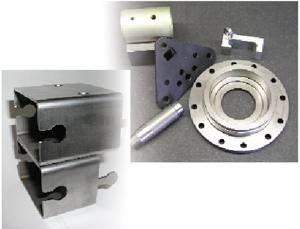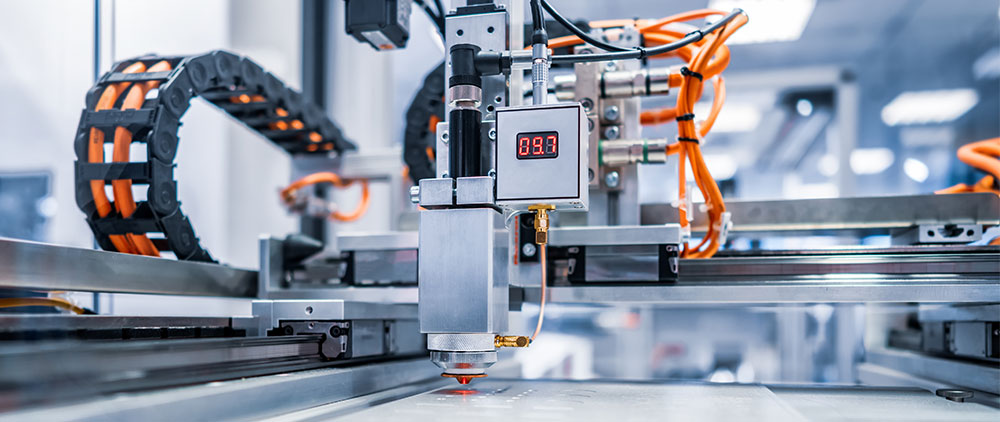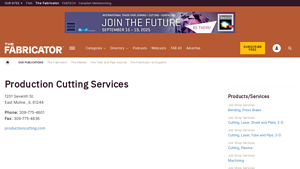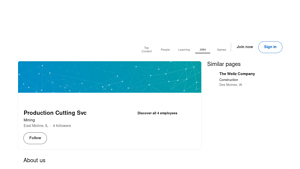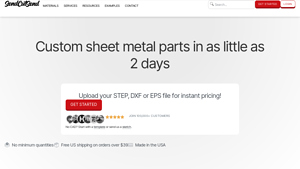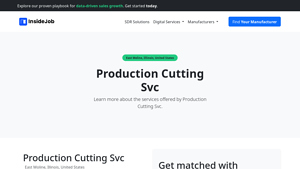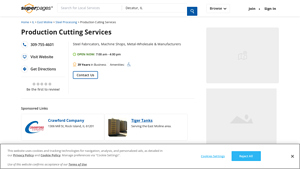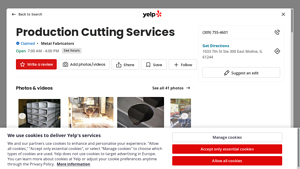Production Cutting Services Guide: Type, Cost, Top List…
Introduction: Navigating the Global Market for production cutting services
In today’s competitive landscape, sourcing high-quality production cutting services is crucial for B2B buyers aiming to enhance operational efficiency and product quality. However, navigating the myriad of options available globally can be daunting, especially for businesses in regions like Africa, South America, the Middle East, and Europe. This guide aims to demystify the complexities of production cutting services, providing valuable insights into various types such as laser cutting, CNC machining, and waterjet cutting. We will also explore their diverse applications across industries, ensuring you understand how to leverage these services to meet your specific needs.
Furthermore, we will delve into essential aspects of supplier vetting, helping you identify reliable partners who not only meet your technical specifications but also adhere to quality standards. Cost considerations will be thoroughly examined, enabling you to make informed financial decisions without compromising quality. This comprehensive resource empowers international B2B buyers, particularly those from Brazil and Saudi Arabia, to make strategic purchasing decisions that align with their operational goals. By the end of this guide, you will be equipped with the knowledge to select the right production cutting services that can drive your business forward and foster long-term partnerships.
Understanding production cutting services Types and Variations
| Type Name | Key Distinguishing Features | Primary B2B Applications | Brief Pros & Cons for Buyers |
|---|---|---|---|
| Laser Cutting | High precision, minimal material waste, versatile materials | Aerospace, automotive, electronics | Pros: Fast production, intricate designs possible. Cons: Higher initial costs for setup. |
| CNC Machining | Computer-controlled cutting, excellent repeatability | Custom parts, prototypes, complex geometries | Pros: High accuracy, suitable for various materials. Cons: Slower for large volumes compared to other methods. |
| Waterjet Cutting | No heat-affected zone, cuts through thick materials | Construction, aerospace, stone fabrication | Pros: Versatile with materials, no thermal distortion. Cons: Slower than laser cutting, may require post-processing. |
| Band Saw Cutting | Ideal for large, heavy materials, continuous cutting | Metal fabrication, construction, woodworking | Pros: Cost-effective for large pieces, minimal waste. Cons: Limited precision compared to laser or CNC. |
| Plasma Cutting | Fast cutting for thick metals, lower cost than laser | Metalworking, industrial applications | Pros: High-speed cutting, effective for thicker materials. Cons: Rougher edges, may require secondary finishing. |
What are the Characteristics of Laser Cutting Services?
Laser cutting is a highly precise method that utilizes a laser to cut materials, making it ideal for intricate designs and detailed patterns. It can handle a wide range of materials, including metals, plastics, and wood, while producing minimal waste. This method is particularly suitable for industries such as aerospace and electronics, where precision is paramount. B2B buyers should consider the initial setup costs, as they can be higher than other methods, but the speed and quality of output often justify the investment.
How Does CNC Machining Stand Out in Production Cutting Services?
CNC machining employs computer numerical control to guide cutting tools, ensuring high repeatability and accuracy. It is particularly effective for creating custom parts and prototypes with complex geometries. This method is favored in sectors like automotive and aerospace, where precision components are essential. While CNC machining can be slower for large volumes compared to laser cutting, its versatility in handling various materials makes it a valuable option for B2B buyers looking for reliability and quality.
What Makes Waterjet Cutting a Versatile Option for B2B Buyers?
Waterjet cutting uses a high-pressure jet of water mixed with abrasive particles to cut through materials without generating heat. This process is advantageous as it eliminates thermal distortion, making it suitable for sensitive materials like composites and metals. Industries such as construction and aerospace often utilize waterjet cutting for its ability to handle thick materials. Buyers should note that while it is versatile, the cutting speed is generally slower than laser methods, and some applications may require additional finishing.
Why Choose Band Saw Cutting for Heavy Materials?
Band saw cutting is particularly effective for large and heavy materials, providing continuous cuts that are cost-effective for bulk operations. This method is commonly used in metal fabrication and woodworking industries. While it offers minimal waste and lower costs for larger pieces, buyers should be aware that the precision may not match that of laser or CNC cutting. Band saw cutting is best suited for projects where speed and material handling outweigh the need for intricate detail.
When is Plasma Cutting the Right Choice for Your Business?
Plasma cutting involves using a plasma torch to cut through electrically conductive materials, making it a rapid option for thick metals. This method is prevalent in metalworking and industrial applications due to its efficiency and cost-effectiveness. However, while plasma cutting can produce results quickly, it may leave rough edges that require secondary finishing processes. B2B buyers should evaluate their need for speed versus the quality of the cut when considering plasma cutting for their projects.
Key Industrial Applications of production cutting services
| Industry/Sector | Specific Application of production cutting services | Value/Benefit for the Business | Key Sourcing Considerations for this Application |
|---|---|---|---|
| Automotive Manufacturing | Precision components for vehicle assembly | Enhances assembly efficiency and reduces waste | Need for rapid prototyping and strict quality standards |
| Aerospace | Lightweight structural components | Reduces overall weight, improving fuel efficiency | Compliance with stringent aerospace regulations |
| Construction & Fabrication | Custom metal parts for structural support | Increases durability and project timelines | Material sourcing and local regulations are critical |
| Energy & Utilities | Components for renewable energy systems | Supports sustainable practices and reduces costs | Customization to fit specific energy applications |
| Electronics | Enclosures and heat sinks for electronic devices | Improves product reliability and performance | Precision in cutting and finishing is essential |
How Are Production Cutting Services Used in Automotive Manufacturing?
In the automotive sector, production cutting services are essential for creating precision components that are integral to vehicle assembly. These services help manufacturers produce parts such as brackets, housings, and chassis components with high accuracy and consistency. The key problems solved include reducing assembly time and minimizing material waste, which directly impacts the bottom line. International buyers, particularly from regions like South America and Africa, should consider suppliers that can provide rapid prototyping and adhere to strict quality standards to meet their production timelines.
What Role Do Cutting Services Play in Aerospace Applications?
In aerospace, production cutting services are utilized to fabricate lightweight structural components like wing frames and fuselage parts. The critical benefit here is the reduction in overall aircraft weight, which enhances fuel efficiency—a significant concern for airlines worldwide. Buyers from the Middle East and Europe must ensure their suppliers comply with stringent aerospace regulations and certifications, which can vary by region, to avoid costly delays and ensure safety compliance.
How Are Cutting Services Applied in Construction & Fabrication?
Production cutting services are vital in the construction and fabrication industry, where custom metal parts are required for structural support and architectural features. These services provide the durability needed for load-bearing applications while also allowing for quicker project timelines. Businesses sourcing these services must consider local regulations regarding materials and safety standards, especially in diverse markets like Brazil and Saudi Arabia, to ensure compliance and quality.
Why Are Cutting Services Important in Energy & Utilities?
In the energy sector, particularly in renewable energy systems, production cutting services are employed to manufacture specialized components such as brackets for solar panels or turbine parts for wind energy systems. The value lies in supporting sustainable practices while also reducing operational costs. International buyers should focus on suppliers who can offer customization options to fit specific energy applications, as well as those who understand the unique challenges of sourcing materials in different regions.
How Do Production Cutting Services Enhance Electronics Manufacturing?
Production cutting services are integral to the electronics industry, where they are used to create enclosures and heat sinks that protect and manage electronic components. The main benefit is the improvement in product reliability and performance, which is crucial in a highly competitive market. Buyers in Europe and the Middle East should prioritize suppliers that provide precision cutting and finishing services, as the electronics sector demands high-quality standards to ensure product longevity and functionality.
3 Common User Pain Points for ‘production cutting services’ & Their Solutions
Scenario 1: Meeting Tight Deadlines with Production Cutting Services
The Problem: In the fast-paced world of manufacturing, time is often a critical factor. A B2B buyer may face the challenge of needing custom-cut parts quickly to meet an unexpected surge in demand or a delayed project timeline. Delays in receiving these parts can lead to production bottlenecks, missed deadlines, and ultimately, dissatisfied clients. For international buyers, time zone differences and shipping logistics can exacerbate the urgency, making it even more challenging to secure timely delivery.
The Solution: To overcome this challenge, buyers should prioritize sourcing production cutting services that offer expedited processing options. When approaching suppliers, inquire about their lead times for different cutting methods (e.g., laser cutting, CNC machining) and their capacity to handle urgent requests. Establishing a relationship with a provider that guarantees quick turnaround times—ideally within 2-4 days for standard orders—can also provide a competitive edge. Additionally, consider using online platforms that allow for instant pricing and order tracking; this transparency can streamline the purchasing process and help in planning logistics more effectively.
Scenario 2: Ensuring High-Quality Standards in Custom Parts
The Problem: Quality assurance is paramount in production cutting services, especially for sectors such as aerospace, automotive, or medical manufacturing. A buyer might encounter issues with parts that do not meet specifications, leading to costly reworks or, worse, safety hazards. This is particularly concerning for international buyers who may have limited oversight of overseas manufacturing processes, making it harder to enforce quality standards.
The Solution: To mitigate quality issues, B2B buyers should thoroughly vet production cutting service providers before committing to orders. This includes reviewing their Quality Management System (QMS) and certification (e.g., ISO 9001). Request samples of previous work and ask for detailed documentation on their cutting processes, materials used, and inspection protocols. Establishing clear specifications upfront is crucial; consider providing detailed engineering drawings and material requirements. Regular communication throughout the production process can also help ensure adherence to quality standards and allow for adjustments before final delivery.
Scenario 3: Navigating Complex Material Choices and Specifications
The Problem: With a plethora of materials available for production cutting, buyers often struggle to choose the right one for their specific applications. Each material comes with its own set of properties, costs, and cutting requirements, which can be overwhelming, especially for buyers who may not have a technical background. This confusion can lead to selecting suboptimal materials that affect the performance and durability of the final product.
The Solution: To navigate material selection effectively, buyers should engage closely with their production cutting service provider. It’s essential to communicate the specific requirements of the project, including desired properties like strength, weight, and corrosion resistance. Suppliers often have extensive knowledge of materials and can provide insights into the best options based on the intended application. Additionally, utilizing online configurators and templates can simplify the process of material selection and pricing. Buyers should also consider establishing a partnership with a supplier who offers a variety of materials and can provide advice on the latest innovations in cutting technology, ensuring that they make informed decisions that align with their project goals.
By addressing these common pain points with actionable strategies, B2B buyers can enhance their experience with production cutting services, ensuring timely delivery, high quality, and optimal material selection for their manufacturing needs.
Strategic Material Selection Guide for production cutting services
What Are the Key Properties of Common Materials Used in Production Cutting Services?
In the realm of production cutting services, selecting the right material is crucial for achieving optimal performance and cost-effectiveness. Below, we analyze four common materials: Mild Steel, Stainless Steel, Aluminum, and Carbon Fiber. Each material presents unique properties, advantages, and limitations that cater to different applications.
Mild Steel: A Versatile Choice for Many Applications
Mild steel is known for its excellent machinability and weldability, making it a popular choice in various industries. Its key properties include good tensile strength and ductility, with a temperature rating suitable for moderate applications. However, mild steel is prone to corrosion, necessitating protective coatings or treatments for outdoor use.
Pros:
– Cost-effective and widely available.
– Easy to work with due to its malleability.
Cons:
– Lower corrosion resistance compared to other metals.
– Requires surface treatments for prolonged durability.
For international buyers, especially in regions like Africa and South America, compliance with local standards (such as ASTM A36) is essential. Understanding regional preferences for coatings can also influence purchasing decisions.
Stainless Steel: Superior Corrosion Resistance and Strength
Stainless steel is renowned for its corrosion resistance, making it ideal for applications exposed to harsh environments. Key properties include high tensile strength and the ability to withstand high temperatures without losing integrity. Common grades like 304 and 316 are frequently used in production cutting services.
Pros:
– Excellent durability and longevity.
– Low maintenance due to corrosion resistance.
Cons:
– Higher cost compared to mild steel.
– More challenging to machine, increasing manufacturing complexity.
International buyers, particularly from the Middle East and Europe, should consider compliance with standards such as ASTM A240 or EN 10088. The selection of stainless steel grades may also depend on specific applications, such as food processing or chemical handling.
Aluminum: Lightweight and Highly Versatile
Aluminum is favored for its lightweight nature and excellent corrosion resistance. Its key properties include a high strength-to-weight ratio and good thermal conductivity, making it suitable for various applications, including automotive and aerospace industries.
Pros:
– Lightweight, reducing shipping costs.
– Excellent corrosion resistance without additional coatings.
Cons:
– Generally more expensive than mild steel.
– Lower strength compared to stainless steel in certain applications.
For B2B buyers in regions like Brazil, understanding the local supply chain for aluminum alloys (such as 6061 or 7075) can be advantageous. Compliance with standards like ASTM B221 is also important for ensuring quality and performance.
Carbon Fiber: Advanced Material for Specialized Applications
Carbon fiber is an advanced composite material known for its exceptional strength and lightweight properties. It exhibits high stiffness and low thermal expansion, making it suitable for high-performance applications, such as aerospace and sports equipment.
Pros:
– Extremely strong yet lightweight.
– Excellent fatigue resistance.
Cons:
– High manufacturing costs and complexity.
– Limited compatibility with certain environments (e.g., high humidity).
International buyers should be aware of the specific standards governing carbon fiber products, such as ASTM D7264. Understanding the local market for carbon fiber can also help in sourcing competitive pricing and quality.
Summary of Material Selection for Production Cutting Services
| Material | Typical Use Case for production cutting services | Key Advantage | Key Disadvantage/Limitation | Relative Cost (Low/Med/High) |
|---|---|---|---|---|
| Mild Steel | General fabrication, automotive components | Cost-effective and widely available | Lower corrosion resistance | Low |
| Stainless Steel | Food processing, medical equipment | Excellent durability and low maintenance | Higher cost and machining complexity | High |
| Aluminum | Aerospace, automotive parts | Lightweight with good corrosion resistance | More expensive than mild steel | Medium |
| Carbon Fiber | Aerospace, high-performance sports equipment | Extremely strong yet lightweight | High manufacturing costs | High |
This guide serves to inform B2B buyers about the strategic selection of materials in production cutting services, helping them make informed decisions that align with their operational needs and regional compliance requirements.
In-depth Look: Manufacturing Processes and Quality Assurance for production cutting services
What Are the Typical Manufacturing Processes for Production Cutting Services?
Manufacturing processes for production cutting services encompass several stages, each critical to ensuring the final product meets the exact specifications and quality standards required by B2B buyers. These stages typically include material preparation, forming, assembly, and finishing.
How is Material Prepared in Production Cutting Services?
The first step in the manufacturing process involves material preparation, where raw materials are selected based on the specific requirements of the project. This may include metals, plastics, or composites, depending on the application. Suppliers often use advanced technologies like CNC (Computer Numerical Control) and laser cutting to ensure precision from the outset.
During this stage, materials are cut to size and inspected for quality. Material preparation also includes the evaluation of the material’s properties, such as tensile strength and corrosion resistance, which are crucial for ensuring durability in the final product.
What Forming Techniques Are Commonly Used in Production Cutting?
Once the materials are prepared, the forming stage begins. This phase employs various techniques, including:
-
Laser Cutting: A highly precise method that uses focused laser beams to cut materials into specified shapes. It’s suitable for complex designs and thin materials.
-
CNC Machining: This technique utilizes computer-controlled tools to remove material and create intricate parts with high accuracy.
-
Waterjet Cutting: An effective method for cutting thick materials without generating heat, thus preventing warping.
These forming techniques are essential for achieving the desired dimensions and tolerances. The choice of technique often depends on the material type, thickness, and required precision.
How Does the Assembly Process Work in Production Cutting Services?
In the assembly stage, the cut parts are brought together to create the final product. This may involve welding, riveting, or mechanical fastening, depending on the design requirements. Effective assembly techniques ensure structural integrity and functionality.
Collaboration with design engineers during this phase can enhance efficiency, as they can provide insights into optimizing the assembly process for cost-effectiveness and speed. For instance, modular designs can simplify assembly and reduce production time.
What Finishing Processes Are Necessary for Production Cutting Services?
Finishing processes are vital for enhancing the aesthetic appeal and functionality of the final product. Common finishing techniques include:
-
Deburring: Removing sharp edges or burrs from cut parts to improve safety and fit.
-
Anodizing: A process primarily used for aluminum that enhances corrosion resistance and surface hardness.
-
Powder Coating: A finishing technique that provides a protective layer while allowing for a variety of colors and textures.
These finishing processes not only contribute to the product’s appearance but also significantly impact its performance and longevity in various applications.
What Quality Assurance Standards Are Relevant for Production Cutting Services?
Quality assurance (QA) is a critical component of production cutting services, ensuring that products meet international and industry-specific standards. The most recognized international standard is ISO 9001, which outlines requirements for a quality management system (QMS) that organizations must adhere to. Compliance with ISO 9001 signals to B2B buyers that the supplier is committed to continuous improvement and customer satisfaction.
Which Industry-Specific Standards Should B2B Buyers Consider?
In addition to ISO 9001, various industry-specific standards may apply, depending on the application. For example:
-
CE Marking: Indicates compliance with European safety, health, and environmental protection standards.
-
API Standards: Relevant for suppliers serving the oil and gas industry, ensuring equipment meets safety and performance requirements.
Understanding these standards helps B2B buyers assess the credibility of their suppliers and ensure their products meet necessary regulations.
What Are the Key QC Checkpoints in Production Cutting Services?
Quality control in production cutting services typically involves several checkpoints throughout the manufacturing process:
-
Incoming Quality Control (IQC): This initial checkpoint ensures that raw materials meet specified quality standards before production begins. Suppliers often conduct material certifications and tests to verify compliance.
-
In-Process Quality Control (IPQC): During production, regular inspections are conducted to monitor the manufacturing process. This may include measuring tolerances and verifying that operations are performed correctly.
-
Final Quality Control (FQC): The final checkpoint involves thorough inspections of the completed products to ensure they meet all specifications and quality standards. Common tests may include dimensional checks, functional tests, and surface inspections.
How Can B2B Buyers Verify Supplier Quality Control?
B2B buyers can take several steps to verify the quality control practices of their suppliers:
-
Conduct Audits: Regular audits of the supplier’s facilities can provide insights into their quality management processes and adherence to standards.
-
Request Quality Reports: Suppliers should be able to provide documentation detailing their quality control measures, including test results and certifications.
-
Third-Party Inspections: Engaging independent inspection agencies can offer an unbiased assessment of the supplier’s quality practices and products.
What Are the Quality Control Nuances for International B2B Buyers?
For international B2B buyers, understanding quality control nuances is crucial, particularly when dealing with suppliers from diverse regions like Africa, South America, the Middle East, and Europe.
-
Cultural Differences: Different regions may have varying interpretations of quality standards and practices. Building strong relationships and clear communication can help bridge these gaps.
-
Regulatory Compliance: Buyers must be aware of specific regulations and standards applicable in their own countries, as well as those in the supplier’s country. This includes import/export regulations and compliance with local standards.
-
Logistics and Lead Times: International transactions can introduce complexities in logistics and lead times. Buyers should factor in potential delays and ensure that suppliers can meet delivery schedules without compromising quality.
By understanding these aspects of manufacturing processes and quality assurance, B2B buyers can make informed decisions when selecting production cutting service providers, ultimately leading to successful partnerships and high-quality products.
Practical Sourcing Guide: A Step-by-Step Checklist for ‘production cutting services’
Introduction
This guide is designed to help B2B buyers navigate the process of sourcing production cutting services effectively. By following this step-by-step checklist, you can ensure that you select a supplier that meets your technical requirements, aligns with your budget, and adheres to quality standards essential for your operations.
Step 1: Define Your Technical Specifications
Begin by clearly outlining your project requirements, including dimensions, tolerances, and material types. Establishing precise specifications is crucial as it guides the selection of suitable suppliers and ensures that the final products meet your operational needs. Consider detailing any unique aspects of your project, such as the complexity of designs or the required finishing processes.
Step 2: Research Potential Suppliers
Conduct thorough research to identify potential suppliers specializing in production cutting services. Utilize industry directories, trade shows, and online platforms to compile a list of candidates. Pay attention to suppliers with a strong reputation and extensive experience in your specific industry, as they are more likely to understand your unique challenges and requirements.
Step 3: Evaluate Supplier Capabilities
Assess the technical capabilities of each supplier on your shortlist. Look for services that match your specifications, such as laser cutting, CNC machining, or bending services. Verify that they have the necessary equipment and expertise to handle your project, including precision inspection processes to ensure quality control.
Step 4: Verify Certifications and Compliance
Ensure that your chosen suppliers hold relevant industry certifications and comply with international quality standards. Certifications like ISO 9001 can indicate a commitment to quality management systems. This step is vital to mitigate risks associated with poor quality or non-compliance, especially when dealing with international suppliers.
Step 5: Request Samples and Prototypes
Before finalizing a supplier, ask for samples or prototypes of their work. This allows you to assess their craftsmanship, attention to detail, and ability to meet specifications. Evaluating physical samples can also help you gauge material quality and finishing options, ensuring that they align with your expectations.
Step 6: Compare Pricing and Lead Times
Gather detailed quotes from multiple suppliers, ensuring you understand the factors contributing to their pricing. Look beyond the base price; consider additional costs for post-processing, shipping, and any potential delays. Additionally, clarify lead times to ensure that the supplier can meet your project timelines.
Step 7: Assess Customer Support and Communication
Evaluate the level of customer support and communication offered by each supplier. Effective communication is essential throughout the production process, from initial inquiries to project completion. A supplier that prioritizes responsive and clear communication can enhance collaboration and address any issues that arise promptly.
By following this checklist, you can streamline your sourcing process for production cutting services, leading to successful partnerships that enhance your operational efficiency.
Comprehensive Cost and Pricing Analysis for production cutting services Sourcing
What Are the Key Cost Components in Production Cutting Services?
Understanding the cost structure of production cutting services is essential for B2B buyers looking to optimize their sourcing strategies. The primary cost components include:
-
Materials: The choice of raw materials directly impacts pricing. Options range from steel and aluminum to composites and plastics, each with varying costs. Buyers should evaluate the material’s properties against project requirements to avoid overspending.
-
Labor: Skilled labor is crucial in achieving precision in cutting services. Labor costs can vary significantly based on the region, complexity of the work, and required expertise. For international buyers, understanding local labor markets can yield cost advantages.
-
Manufacturing Overhead: This includes costs related to facility maintenance, utilities, and administrative expenses. Efficient overhead management can lead to more competitive pricing.
-
Tooling: Tooling costs can be significant, especially for custom projects requiring specialized tools. Buyers should inquire about tooling costs upfront to incorporate them into their budget.
-
Quality Control (QC): Ensuring quality through rigorous QC processes is vital. Costs associated with inspections and certifications should be factored into the overall pricing.
-
Logistics: Shipping and handling costs can vary based on distance and delivery methods. Understanding logistics can help buyers negotiate better terms and reduce total costs.
-
Margin: Suppliers typically add a profit margin to cover their costs and risks. Buyers should be aware of standard margins in their industry to gauge pricing competitiveness.
How Do Price Influencers Impact Production Cutting Services Pricing?
Several factors influence the pricing of production cutting services, including:
-
Volume and Minimum Order Quantity (MOQ): Bulk orders often result in lower per-unit costs. Buyers should assess their needs and negotiate MOQs that align with their production schedules.
-
Specifications and Customization: Customized projects generally incur higher costs due to the additional time and resources required. Clearly defined specifications can help avoid unnecessary adjustments and costs.
-
Materials and Quality Certifications: The choice of material and any required quality certifications (e.g., ISO, ASTM) can significantly affect pricing. Buyers should prioritize materials that meet their quality standards while being cost-effective.
-
Supplier Factors: The supplier’s location, reputation, and capacity can influence pricing. Suppliers with advanced technologies may offer more efficient processes, potentially reducing costs.
-
Incoterms: Understanding shipping terms (Incoterms) can help buyers manage costs associated with delivery and responsibilities. Negotiating favorable terms can minimize unexpected expenses.
What Buyer Tips Can Enhance Cost-Efficiency in Sourcing Production Cutting Services?
International B2B buyers can leverage several strategies to enhance cost-efficiency:
-
Negotiate Wisely: Establishing strong relationships with suppliers can lead to better terms. Don’t hesitate to negotiate pricing, especially for larger orders or long-term contracts.
-
Consider Total Cost of Ownership (TCO): Evaluate not just the initial purchase price but also the long-term costs associated with maintenance, logistics, and potential rework. This broader perspective can lead to more informed decisions.
-
Be Aware of Pricing Nuances for International Transactions: Currency fluctuations, tariffs, and import duties can impact overall costs. Buyers should conduct thorough market research to anticipate these factors.
-
Engage in Early Discussions: Collaborating with suppliers early in the design process can yield insights into cost-saving measures and innovative solutions, allowing for adjustments before production begins.
Conclusion
While indicative prices can vary widely based on the factors discussed, understanding the cost components and price influencers will empower B2B buyers to make informed sourcing decisions. By adopting strategic negotiation techniques and considering the total cost of ownership, companies from Africa, South America, the Middle East, and Europe can optimize their procurement processes in production cutting services.
Alternatives Analysis: Comparing production cutting services With Other Solutions
Understanding the Value of Production Cutting Services and Its Alternatives
In the competitive landscape of manufacturing, selecting the right production method is crucial for operational efficiency and cost-effectiveness. Production cutting services offer specialized solutions for precise metal fabrication, but there are alternative methods available. Understanding these alternatives can help B2B buyers make informed decisions tailored to their specific project needs.
| Comparison Aspect | Production Cutting Services | Alternative 1: Waterjet Cutting | Alternative 2: Traditional Machining |
|---|---|---|---|
| Performance | High precision, custom specifications | Excellent for complex shapes, no heat-affected zone | High precision, but limited to simpler shapes |
| Cost | Variable based on complexity and volume | Generally higher setup costs but low operating costs | Often lower initial costs but higher labor costs |
| Ease of Implementation | Requires CAD files; quick turnaround | Requires specialized equipment and setup time | Straightforward setup, widely available tools |
| Maintenance | Low, with regular equipment checks | Moderate, equipment requires routine maintenance | High, due to wear and tear on tools |
| Best Use Case | Custom parts in various industries | Ideal for intricate designs and materials | Suitable for high-volume production runs |
What Are the Pros and Cons of Waterjet Cutting as an Alternative?
Waterjet cutting is a versatile method that uses high-pressure water mixed with abrasives to cut through materials. One of its primary advantages is its ability to cut complex shapes without generating heat, which minimizes the risk of warping. This makes it suitable for materials sensitive to temperature changes, such as plastics and composites. However, waterjet cutting typically has higher setup costs and can be slower than traditional methods for larger batches, making it less ideal for projects with tight deadlines or budget constraints.
How Does Traditional Machining Compare to Production Cutting Services?
Traditional machining involves the use of cutting tools to shape materials into desired forms. This method is known for its cost-effectiveness, particularly for high-volume production runs. The initial setup costs are generally lower, and the technology is widely available across many manufacturing facilities. However, traditional machining is often limited to simpler shapes and may not achieve the precision required for more complex designs. Additionally, the wear and tear on tools can lead to higher maintenance costs over time.
Making the Right Choice: How Can B2B Buyers Select the Best Solution?
Choosing the right production method hinges on several factors, including project specifications, budget constraints, and desired turnaround times. B2B buyers should carefully evaluate their specific needs—such as the complexity of the part, material type, and production volume—against the capabilities of each alternative. For projects requiring high precision and customization, production cutting services may be the best fit. Conversely, for simpler parts or larger batches, traditional machining or waterjet cutting could offer better value.
By understanding the strengths and weaknesses of each option, buyers can make strategic decisions that align with their operational goals, ultimately enhancing efficiency and profitability in their manufacturing processes.
Essential Technical Properties and Trade Terminology for production cutting services
What Are the Key Technical Properties in Production Cutting Services?
Understanding the critical technical properties involved in production cutting services is essential for B2B buyers looking to optimize their manufacturing processes. Here are some vital specifications:
-
Material Grade
Material grade refers to the classification of materials based on their mechanical and chemical properties. Common materials used in production cutting include stainless steel, aluminum, and carbon steel. Selecting the appropriate grade is crucial as it affects the durability, strength, and overall performance of the final product. Buyers must ensure the chosen material meets their specific application requirements to avoid costly failures. -
Tolerance
Tolerance defines the permissible limit of variation in a physical dimension. In production cutting, tight tolerances are essential for ensuring parts fit together correctly and function as intended. For example, a tolerance of ±0.01 mm may be required for intricate assemblies. Understanding tolerances helps buyers communicate their needs effectively and ensures quality assurance throughout the manufacturing process. -
Thickness
The thickness of the material being cut is a critical property that influences the cutting method and tooling required. Different processes, such as laser cutting or waterjet cutting, have varying capabilities for material thickness. Knowing the required thickness helps buyers select the right cutting service provider, ensuring that their specifications are met without compromising quality or increasing costs. -
Surface Finish
Surface finish refers to the texture and quality of the surface after cutting, which can affect the part’s performance and aesthetics. Common finishes include polished, anodized, or coated surfaces. Buyers should specify their surface finish requirements to ensure that the final product aligns with their design and functional expectations. -
Batch Size
Batch size indicates the number of parts produced in a single manufacturing run. This property impacts pricing, lead times, and production methods. Understanding the implications of batch size helps buyers manage their inventory and production schedules effectively, ensuring that they receive the right quantity of parts when needed.
What Are Common Trade Terms in Production Cutting Services?
Familiarity with industry jargon can streamline communication between B2B buyers and suppliers. Here are some essential trade terms:
-
OEM (Original Equipment Manufacturer)
An OEM is a company that produces parts or equipment that may be marketed by another manufacturer. In production cutting, working with an OEM can ensure that the components meet specific standards required for integration into larger systems or products. -
MOQ (Minimum Order Quantity)
MOQ refers to the smallest number of units that a supplier is willing to sell in a single order. Understanding MOQs helps buyers assess their purchasing power and negotiate terms with suppliers. This is particularly important for startups or companies looking to test new products without committing to large inventories. -
RFQ (Request for Quotation)
An RFQ is a formal process used by buyers to solicit price quotes from suppliers for specific products or services. Including detailed specifications in an RFQ can lead to more accurate quotations and ultimately help in comparing different suppliers effectively. -
Incoterms (International Commercial Terms)
Incoterms are a set of predefined international trade terms that define the responsibilities of buyers and sellers regarding the delivery of goods. Understanding Incoterms is vital for managing logistics and ensuring compliance with international trade regulations. -
Lead Time
Lead time is the total time from the initiation of a process until its completion, including production and shipping. Awareness of lead times helps buyers plan their operations, manage expectations, and align their supply chain processes with production schedules.
By grasping these technical properties and trade terms, B2B buyers can make informed decisions that enhance their operational efficiency and foster successful partnerships in the production cutting services sector.
Navigating Market Dynamics and Sourcing Trends in the production cutting services Sector
What Are the Key Trends Influencing the Production Cutting Services Market?
The production cutting services market is currently shaped by several global drivers, including technological advancements, increasing demand for customized solutions, and a growing emphasis on operational efficiency. With the rise of Industry 4.0, automation and AI are becoming integral in optimizing manufacturing processes, enabling companies to provide faster turnaround times and higher precision. International B2B buyers, particularly from regions like Africa, South America, the Middle East, and Europe, are increasingly seeking suppliers that can offer rapid prototyping and flexible manufacturing capabilities. This shift towards custom solutions is driven by the need for tailored parts that meet specific industry requirements, from automotive to aerospace.
Emerging trends such as the adoption of cloud-based platforms for order management and real-time tracking are also changing the landscape. These technologies facilitate better communication and transparency between buyers and suppliers, enabling more efficient sourcing processes. Additionally, the focus on sustainability is becoming a crucial factor in purchasing decisions, as companies aim to align with global environmental standards. As such, international buyers are looking for suppliers that not only deliver quality but also demonstrate a commitment to sustainable practices.
How Are Sustainability and Ethical Sourcing Changing the Production Cutting Services Sector?
Sustainability and ethical sourcing are increasingly vital considerations for B2B buyers in the production cutting services sector. The environmental impact of manufacturing processes, including waste generation and energy consumption, has led to a growing demand for suppliers who prioritize eco-friendly practices. Buyers are looking for companies that utilize renewable energy, minimize waste, and recycle materials wherever possible.
Furthermore, the importance of ethical supply chains cannot be overstated. Buyers are increasingly concerned about the social implications of their sourcing decisions, including labor practices and community impact. Suppliers that can demonstrate compliance with ethical standards and certifications not only enhance their credibility but also attract conscientious buyers.
In response to these trends, many companies in the production cutting services sector are adopting ‘green’ certifications and using environmentally friendly materials. This includes sourcing metals with lower carbon footprints and utilizing non-toxic finishing processes. Buyers can enhance their corporate social responsibility profiles by partnering with suppliers committed to sustainable and ethical practices.
What Is the Historical Context of Production Cutting Services?
The production cutting services sector has evolved significantly over the decades, transitioning from traditional manual processes to highly automated and technologically advanced methods. In the early days, metal fabrication relied heavily on skilled labor and rudimentary machinery. However, with the advent of CNC (Computer Numerical Control) technology in the late 20th century, precision and efficiency drastically improved.
As industries expanded globally, so did the need for faster and more reliable production methods. The integration of laser cutting and waterjet cutting technologies further revolutionized the sector, allowing for intricate designs and complex geometries that were previously unattainable. Today, the focus is not only on efficiency and precision but also on sustainability and ethical sourcing, marking a new era in the production cutting services landscape. International B2B buyers now seek partners who can offer innovative solutions that meet both their operational needs and ethical standards.
Frequently Asked Questions (FAQs) for B2B Buyers of production cutting services
-
How do I choose the right production cutting service provider for my needs?
Choosing the right production cutting service requires a thorough assessment of your specific project needs. Start by reviewing potential suppliers’ capabilities, including cutting methods (like laser or CNC), material options, and quality control processes. Verify their experience in your industry and check client testimonials or case studies to gauge their reliability. Additionally, consider their ability to meet deadlines and accommodate custom specifications. A provider that emphasizes quality planning, cutting to specification, and continuous improvement is likely to deliver the best results. -
What factors should I consider when customizing my production cutting order?
When customizing your order, consider the materials you need, the complexity of the design, and the specific cutting methods required. Ensure your designs are compatible with the provider’s capabilities, such as tolerances for CNC machining or laser cutting. Discuss any finishing services you may need, such as anodizing or powder coating. Additionally, inquire about minimum order quantities (MOQs) and lead times, as these factors can impact your overall project timeline and budget. -
What are the typical minimum order quantities (MOQs) for production cutting services?
Minimum order quantities can vary significantly among production cutting service providers. Some may accommodate small batch orders, while others might require larger quantities to optimize their manufacturing processes. It’s essential to clarify MOQs during your initial discussions to ensure they align with your project requirements. If you anticipate fluctuating demand, consider partnering with a provider that offers flexibility in order sizes to help manage inventory effectively. -
How do international trade regulations affect sourcing production cutting services?
International trade regulations can significantly impact sourcing production cutting services, particularly regarding tariffs, import/export restrictions, and compliance with local standards. It’s crucial to understand the regulations in both your country and that of your supplier. Partnering with a supplier experienced in international trade can help navigate these complexities. Ensure that all necessary documentation, such as Certificates of Origin and compliance certificates, are in place to avoid delays and additional costs. -
What payment terms should I expect when engaging with a production cutting service?
Payment terms can vary widely among production cutting service providers. Common practices include upfront deposits, net payment terms (such as net 30 or net 60), or payment upon delivery. It’s vital to discuss payment terms early in the negotiation process to ensure they align with your cash flow needs. Some suppliers may also offer financing options or discounts for early payments, which can be beneficial for managing project budgets. -
How can I ensure quality assurance in my production cutting order?
To ensure quality assurance, select a provider with a robust quality management system in place. Ask about their inspection processes, certifications (such as ISO), and how they handle defects or rework. Request samples or prototypes before full-scale production to assess the quality of their work. Establish clear communication channels for feedback throughout the project, and consider conducting regular audits or reviews to monitor quality and adherence to specifications. -
What logistics considerations should I keep in mind when sourcing production cutting services?
Logistics play a crucial role in sourcing production cutting services, especially for international shipments. Consider the lead times for production and shipping, as well as the reliability of the provider’s logistics partners. Discuss shipping options, costs, and delivery timelines upfront. It’s also wise to clarify responsibility for customs duties and insurance during transit to avoid unexpected expenses. Having a clear logistics plan can help ensure timely delivery and minimize disruptions to your supply chain. -
How do I evaluate the reliability of a production cutting service supplier?
Evaluating the reliability of a supplier involves assessing several key factors: their track record, customer reviews, and industry certifications. Look for suppliers with a history of delivering quality products on time and within budget. Request references from previous clients to gain insights into their experiences. Additionally, consider the supplier’s communication style and responsiveness, as effective communication is vital for successful project execution. A reliable partner will actively engage with you to understand your needs and provide solutions that align with your business objectives.
Important Disclaimer & Terms of Use
⚠️ Important Disclaimer
The information provided in this guide, including content regarding manufacturers, technical specifications, and market analysis, is for informational and educational purposes only. It does not constitute professional procurement advice, financial advice, or legal advice.
While we have made every effort to ensure the accuracy and timeliness of the information, we are not responsible for any errors, omissions, or outdated information. Market conditions, company details, and technical standards are subject to change.
B2B buyers must conduct their own independent and thorough due diligence before making any purchasing decisions. This includes contacting suppliers directly, verifying certifications, requesting samples, and seeking professional consultation. The risk of relying on any information in this guide is borne solely by the reader.
Top 7 Production Cutting Services Manufacturers & Suppliers List
1. Production Cutting Services – Job Shop Solutions
Domain: thefabricator.com
Registered: 1999 (26 years)
Introduction: Production Cutting Services offers a range of job shop services including: Bending (Press Brake), Laser Cutting for Sheet and Plate, 3-D Laser Cutting for Tube and Pipe, Plasma Cutting, Machining, and Tube and Pipe Fabricating. The company has been in operation since 1985, evolving from a service center to a fabricator with finishing capabilities.
2. LinkedIn – Dedicated API
Domain: linkedin.com
Registered: 2002 (23 years)
Introduction: To scrape Linkedin use our dedicated Linkedin API.
3. SendCutSend – Custom Sheet Metal Fabrication
Domain: sendcutsend.com
Registered: 2015 (10 years)
Introduction: SendCutSend offers custom sheet metal fabrication services including laser cutting, CNC routing, waterjet cutting, anodizing, bending & forming, countersinking, dimple forming, hardware insertion, plating, powder coating, tapping, tumbling, and deburring. They provide instant pricing for custom parts with no minimum quantities and free US shipping on orders over $39. Standard orders are processed …
4. PCS – Precision Metal Fabrication Solutions
Domain: insidejobsales.com
Registered: 2024 (1 years)
Introduction: Production Cutting Services, Inc. (PCS) is a premier provider of precision metal fabrication and cutting solutions. Established in 1985, PCS specializes in advanced manufacturing processes including laser cutting, CNC machining, CNC tuning, drill-saw systems, bending services, band and cold saw cutting, and lathe tube cutoff. PCS operates with a commitment to quality and precision, utilizing the l…
5. Production Cutting Services – Metal Processing Solutions
Domain: superpages.com
Registered: 1996 (29 years)
Introduction: Production Cutting Services, Inc. offers a wide range of metal processing capabilities including complex machined parts, 3-dimensional formed laser cut components, tube spacers, bushings, and large drilled, laser cut, or bent parts. They ensure on-time delivery of the right part at the right time. The company has been in business for 39 years and operates Monday to Friday from 7:00 am to 4:00 pm. …
6. Prosaw – Cutting Services
Domain: facebook.com
Registered: 1997 (28 years)
Introduction: This company, Prosaw – Cutting Services, is a notable entity in the market. For specific product details, it is recommended to visit their website directly.
7. Production Cutting Services – Metal Fabrication
Domain: yelp.com
Registered: 2003 (22 years)
Introduction: Production Cutting Services is a metal fabrication company located at 1033 7th St Ste 300, East Moline, IL 61244. They are open Monday to Friday from 7:00 AM to 4:00 PM and are closed on Saturdays and Sundays. The phone number for the business is (309) 755-4601.
Strategic Sourcing Conclusion and Outlook for production cutting services
How Can Strategic Sourcing Elevate Your Production Cutting Services?
In today’s competitive landscape, strategic sourcing is pivotal for optimizing production cutting services. By focusing on quality, precision, and adaptability, companies can ensure that their sourcing decisions align with both immediate needs and long-term goals. The integration of advanced technologies, such as CNC machining and laser cutting, not only enhances operational efficiency but also reduces costs while meeting stringent specifications.
For international B2B buyers, particularly in regions like Africa, South America, the Middle East, and Europe, the ability to source cutting services that are tailored to unique project requirements is invaluable. Establishing partnerships with experienced providers can facilitate smoother workflows and foster innovation, enabling businesses to remain agile in a fast-evolving market.
As we look toward the future, consider the transformative potential of leveraging strategic sourcing in your operations. By prioritizing collaboration with skilled suppliers, you can unlock new opportunities for growth and success. Now is the time to connect with industry leaders in production cutting services to elevate your projects and drive operational excellence.
